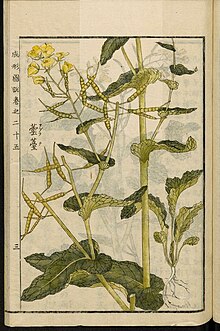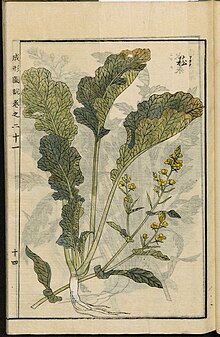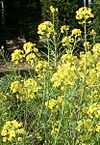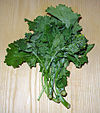Brassica rapa
| Brassica rapa | |
|---|---|

| |
| Scientific classification | |
| Kingdom: | Plantae |
| Clade: | Tracheophytes |
| Clade: | Angiosperms |
| Clade: | Eudicots |
| Clade: | Rosids |
| Order: | Brassicales |
| Family: | Brassicaceae |
| Genus: | Brassica |
| Species: | B. rapa
|
| Binomial name | |
| Brassica rapa | |

Brassica rapa is a plant species growing in various widely cultivated forms including the turnip (a root vegetable); napa cabbage, bomdong, bok choy, and rapini; and Brassica rapa subsp. oleifera, an oilseed which has many common names, including turnip rape, field mustard, bird rape, and keblock.[1][2][3][4][5][6]
The oil made from the seed is sometimes also called canola or colza,[1] which is one reason why it is sometimes confused with rapeseed oil, but this comes from a different Brassica species, Brassica napus. The oilseeds known as canola are sometimes particular varieties of Brassica rapa (termed Polish canola) but usually the related species Brassica napus (rapeseed) and Brassica juncea (mustard greens and mizuna).[7]
History

Oilseed subspecies (oleifera) of Brassica rapa may have been domesticated several times from the Mediterranean to India, starting as early as 2000 BC.[8] Edible turnips were possibly first cultivated in northern Europe, and were an important food in ancient Rome.[8] The turnip then spread east to China, and reached Japan by 700 AD.[8]
In the 18th century the turnip and the oilseed-producing variants were seen as being different species by Carl Linnaeus who named them B. rapa and B. campestris. 20th-century taxonomists found that the plants were cross fertile and thus belonged to the same species. Since the turnip had been named first by Linnaeus, the name Brassica rapa was adopted.[9]
Many butterflies, including the small white, feed from and pollinate the B. rapa flowers.
Cultivars
| Cultivar | Image | Name |
|---|---|---|
| Bok choy |  |
Brassica rapa subsp. chinensis |
| Bomdong |  |
Brassica rapa var. glabra |
| Choy sum |  |
Brassica rapa subsp. parachinensis |
| Field mustard |  |
Brassica rapa subsp. oleifera |
| Komatsuna |  |
Brassica rapa subsp. perviridis |
| Napa cabbage |  |
Brassica rapa subsp. pekinensis |
| Rapini |  |
Brassica rapa var. rapifera |
| Tatsoi |  |
Brassica rapa subsp. narinosa |
| Turnip |  |
Brassica rapa subsp. rapa |
| Yellow sarson |  |
Brassica rapa subsp. trilocularis |
References
- ^ a b "Brassica rapa subsp. oleifera". Germplasm Resources Information Network. Agricultural Research Service, United States Department of Agriculture. Retrieved 13 April 2013.
- ^ "Brassica rapa subsp. oleifera". Turnip Rape. EOL. Retrieved 13 April 2013.
- ^ Clive Stace (1997). New Flora of the British Isles. Cambridge: Cambridge. ISBN 978-0-521-58935-2.
- ^ Bailey's Dictionary (5th reprint ed.). 1731.
- ^ Doreathea Hurst (1889). History and Antiquities Of Horsham. Farncombe & Co.
- ^ "Brassica rapa". Bioimages. cas.vanderbilt.edu. 2011. Archived from the original on 27 June 2010. Retrieved 10 June 2010.
- ^ "Chapter 2 – Canola Varieties". Canola Grower's Manual. Canada Council of Canada. Retrieved 1 May 2014.
- ^ a b c Sanderson, Helen (2005). Prance, Ghillean; Nesbitt, Mark (eds.). The Cultural History of Plants. Routledge. p. 72. ISBN 0415927463.
- ^ Phil Thomas, ed. (2003). "Canola Varieties". Canola Growers Manual. Canola Council of Canada. Archived from the original on 12 July 2009.
External links
 Media related to Brassica rapa at Wikimedia Commons
Media related to Brassica rapa at Wikimedia Commons- " Multilingual taxonomic information". University of Melbourne.
- PROTA (Plant Resources of Tropical Africa) database record on Brassica rapa L.
